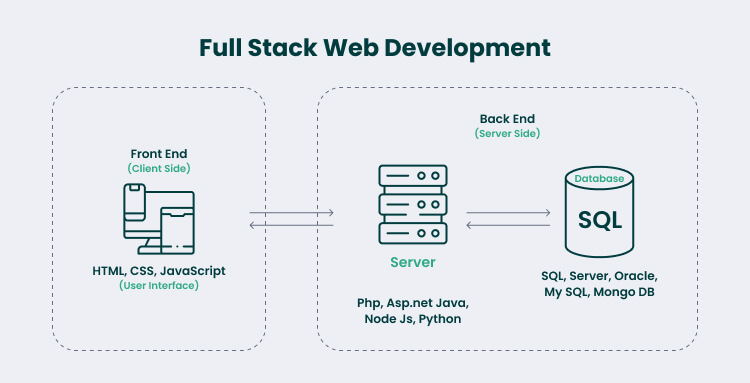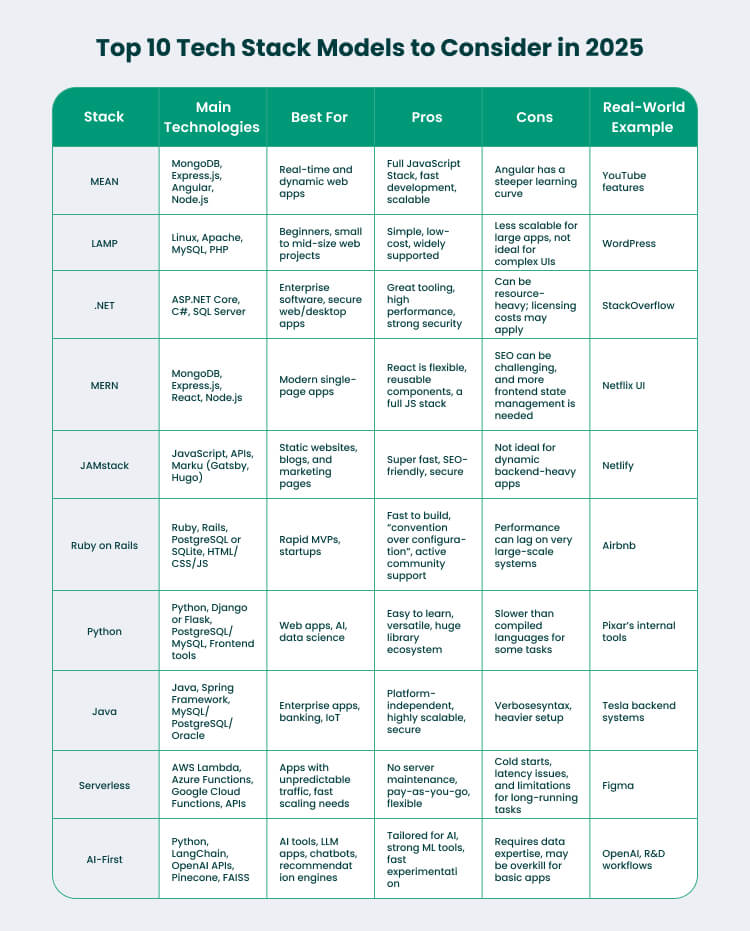Choosing the wrong tech stack can cost your business time, money, and progress. It can slow down your development. Your product will be harder to scale and maintain. On top of that, picking the wrong technologies for your project might cause performance drops and even system crashes.
Many teams get stuck with tools that don’t scale, fail to integrate well, or simply can’t fit their product goals. That’s why picking the right tech stack is one of the most critical early decisions in any software project. As one developer aptly put it on Twitter:

So, what is a tech stack? With so many languages, frameworks, and platforms available today, how do you choose the right one for your project? In this article, we’ll cover that down and share expert tips from Forbytes to help you build an efficient, scalable, and future-proof solution.
What Is a Tech Stack?
The first question we should answer now is: What is a tech stack? It’s a set of technologies used to develop and run an application. It includes programming languages, frameworks, databases, frontend and backend tools, and APIs.
The choice of your tech stack influences everything: from the kind of software integrations you can create to the skills you’ll need to hire for your team.
For product companies, the tech stack often includes tools that help measure product performance and user analytics. So, you can be sure that you’re aligned with customer needs. Your tech stack provides your product team with the instruments to build, maintain, and improve your app.
TechCrunch reports that companies waste nearly 30% of their software budget because of poor tech stack management. That’s why businesses have to review their tech stack to spot and cut out unnecessary costs. It’s a key step toward long-term success.
Components of a Modern Tech Stack
Choosing the right tech stack is like laying the foundation for your house: every part matters. A modern tech stack isn’t just about the frontend and backend; it includes everything that keeps your application running and scaling. Let’s break it down!
Frontend: what users see and use
Frontend is the part of your app or website that your potential clients interact with: design, buttons, menus, and content.
- Languages: HTML (structure), CSS (style), and JavaScript (interactivity).
- Popular tools: React, Angular, Vue help you build rich and dynamic interfaces faster.
- Styling helpers: Tailwind CSS, Bootstrap make your design look clean without starting from scratch.
- Build tools: Webpack, Vite bundle and optimize your frontend code so it loads quickly.
Backend: the engine behind the scenes
Backend powers your app by processing data, making decisions, and connecting to databases.
- Languages: Node.js (JavaScript on the server), Python, PHP, Java, .NET.
- Frameworks: Express, Django, Laravel, Spring speed up server-side development.
- APIs: REST or GraphQL let the frontend talk to the backend.
- Auth tools: OAuth, JWT, and Auth keep your app secure with logins and access controls.
Database: where your data lives
A database is like a storage room for all your information, like user profiles, products, and orders.
- SQL databases (organized in tables): PostgreSQL, MySQL, SQL Server.
- NoSQL databases (more flexible): MongoDB, Firebase are great for unstructured or fast-moving data.
DevOps & infrastructure: how your app runs and scales
These tools help you launch your app, keep it running smoothly, and handle more users as you grow.
- Cloud providers: AWS, Google Cloud, Azure host your app on powerful servers.
- Containers: Docker, Kubernetes make your app portable and scalable.
- CI/CD tools: GitHub Actions and Jenkins automate testing and deployment.
- Monitoring: Datadog, Prometheus, and New Relic track performance and fix issues fast.
Version control: tracking changes to your code
This keeps a history of every change, so teams can work together and roll back mistakes easily.
- Tools: Git (the system), GitHub, GitLab, Bitbucket (the platforms).
- Testing: making sure everything works. Testing helps you catch bugs before users do.
- Unit tests: Check if individual features work (Jest, Mocha)
- End-to-end tests: Simulate real user flows (Cypress, Playwright)
Analytics: understanding your users
These tools show how people use your product: what they click, how long they stay, and what’s not working.
- Tools: Google Analytics, Mixpanel, Hotjar.
A modern tech stack is more than just code. It’s the full toolkit your team uses to bring your product to life, keep it running, and make it better over time. Each component plays a vital role in shaping performance, user experience, and scalability.
If you’re unsure where to start or want to make the most out of your current setup, our team is here to help you tailor your tech stack to your business needs.
Top 10 Tech Stack Models to Consider in 2025
Now that you know why choosing the right tech stack is a big deal, let’s explore some of the best ones out there. These are popular for good reasons. They’re reliable, scalable, and get the job done efficiently.
1. LAMP stack
Linux + Apache + MySQL + PHP
This classic combo is a favorite for building dynamic websites. It’s simple, cost-effective, and open-source. It’s great for small business websites, blogs, and content management systems.
Real-world use: WordPress, which powers over 40% of all websites, is built on LAMP.
2. .NET stack
ASP.NET Core + C# + Microsoft SQL Server
Backed by Microsoft, this stack is a powerhouse for enterprise-grade applications. It’s secure, high-performing, and works well with Azure and Visual Studio.
Real-world use: StackOverflow relies on the .NET stack to handle millions of visits every day.
3. MEAN stack
MongoDB + Express.js + Angular + Node.js
Everything runs on JavaScript from the frontend to the backend. That makes development faster and smoother. It’s perfect for real-time apps like chat or collaboration tools.
Real-world use: YouTube uses parts of the MEAN stack to boost user engagement in real time. LinkedIn and PayPal have used variations of the MEAN stack to build fast, interactive web applications.
4. MERN stack
MongoDB + Express.js + React + Node.js
MERN stack is like MEAN, but with React instead of Angular. React is great for building fast, interactive UIs. This stack is widely loved for building modern web apps.
Real-world use: Netflix uses MERN for its user interface. Facebook, which maintains React, uses a MERN-like stack in many of its internal tools.
5. JAMstack
JavaScript + APIs + Markup
Want a super-fast, secure website? JAMstack is for you. It separates the frontend from the backend and uses static site generators and APIs for speed and simplicity.
Real-world use: Netlify and GitHub Pages use JAMstack principles to deliver lightning-fast websites.
6. Ruby on Rails (RoR)
A framework built with Ruby that helps developers build web apps fast. RoR follows the “convention over configuration” rule, which means less setup, more coding.
Real-world use: Airbnb was built with RoR, helping them scale quickly without sacrificing quality.
7. Python stack
Python + Django or Flask + Frontend tech
Python is clean, easy to learn, and powerful. Whether you’re building a website, crunching data, or diving into AI, Python’s got your back.
Real-world use: Pixar uses Python for scripting in its animation tools. That’s how Toy Story gets made.
8. Java stack
Java + Spring + Database (like MySQL or PostgreSQL)
Tried and tested, Java is ideal for enterprise systems. It’s fast, secure, and works anywhere.
Real-world use: Tesla uses Java to manage massive data from its vehicles and keep systems running smoothly.
9. Serverless stack
AWS Lambda / Azure Functions + API Gateway + Frontend
No servers to manage, just code that runs when you need it. It’s great for fast, cost-effective scaling.
Real-world use: Figma runs its real-time design tools on a serverless setup to support millions of users without breaking a sweat.
10. AI-First Stack
Python + LangChain + OpenAI + Vector DBs like Pinecone
Perfect for building smart apps like chatbots, AI assistants, and recommendation engines. These tools help you plug into powerful AI models and make them work for your product.
Real-world use: OpenAI uses this combo to power next-gen AI tools with context-aware workflows.
Still unsure what stack to pick? Remember, the best stack for your project depends on what you’re building, your team’s skills, and your budget. Each stack has its strengths, so choose the one that fits your needs best.
Need expert help? Contact Forbytes, and we’ll assist with choosing the optimal stack for your solution.
Why Choosing the Right Tech Stack Is So Important
Believe us, your tech stack can make or break your project. It’s the backbone of your entire app, and picking the right one sets you up for long-term success. Here’s why it’s worth the effort:
First, with the right tech stack, your app will be scalable from the start. That means fewer technical headaches as you gain more users, and more flexibility to grow at your own pace without blowing your budget.
Second, choosing a stack that fits your team’s skills means less learning curve and faster delivery. Whether you’re hiring full-stack devs or using in-house talent, the right tools help your team move quickly and confidently.
Third, when everyone’s on the same page and familiar with the tools, collaboration flows. You’ll spend less time untangling confusion and more time building great features. With the right tech stack, your team works better together.
Fourth, planning your stack ahead of time means fewer surprises down the road. You’ll know what infrastructure, automation, and resources you need, avoiding delays and extra costs. So, you’ll save time and money.
Finally, a tech stack aligned with your goals helps you avoid bloated systems and unnecessary tools. Your app stays lean, efficient, and easier to maintain in the long run.
Your tech stack isn’t just a set of tools, it’s a strategic choice. Make the right one, and you’ll build smarter, faster, and better.
How to Choose the Best Tech Stack for Your Solution
Choosing the right tech stack isn’t about following trends. It’s about understanding your project: its goals, constraints, and the people building it. Here’s a simple process we recommend:
Step 1: Know what you’re building: Get clear on your project’s goals. Who will use it? What should it do? How fast does it need to scale?
Step 2: Consider your limits: You might not have full freedom to choose. Maybe you’re building on top of an existing system or working with specific hardware. Choose tools that fit your setup, and don’t overlook options with strong documentation and community support.
Step 3: Don’t forget compliance: Your tech stack must handle data securely and support traceability, especially for regulated industries like healthcare.
Step 4: Use your team’s strengths: The “perfect” tech stack won’t help if your team doesn’t know how to use it. Learn what they know or plan for training if new tools are a must.
Step 5: Test before you commit: Prototype early. Try a key feature. If it’s clunky or overcomplicated, it’s better to find out now, not halfway through development.
Need expert support? We’re here to help you choose the right stack and avoid costly mistakes. Let’s talk.
Forbytes Tips for Enhancing Your Tech Stack with Modern Technology
The right tech stack can make or break your product. It smooths development, helps you scale as your user base grows, and supports smarter decisions every step of the way.
We’ve gathered insights from our experts, and here’s what they recommend:
Tip 1: Align your stack with business goals
Before adopting any new tool or framework, ask: Does this support our product roadmap, scalability needs, and customer experience goals? Don’t adopt tech for hype, adopt it for purpose.
When we built web shops for HFN, a large home furniture network, we tailored the tech stack to match their strategic goals, such as expanding e-commerce capabilities, reaching a broader audience, and ensuring sustainable growth.
Aligning the tech stack with business objectives ensures that every decision contributes directly to the company’s vision and success.
Tip 2: Modernize legacy systems gradually
A full rewrite can be risky. Instead, refactor core modules, integrate APIs, or introduce microservices.
We helped Offerta.se, Sweden’s largest service provider platform, modernize its legacy system step by step. By gradually upgrading the system, we redesigned it to be faster, more efficient, and easier to scale for the future.
Modernizing legacy systems without disrupting current operations is a crucial strategy for ensuring continuous growth and preventing technical issues.
Tip 3: Use cloud-native tools
Move away from on-prem or static hosting. Leverage cloud platforms like AWS, Azure, or Google Cloud to scale, secure, and automate your systems.
When we migrated HFN’s online store to Google Cloud, we ensured that their infrastructure could scale smoothly without performance drops. This shift allowed them to handle more orders and data while maintaining speed and reliability.
Cloud-native tools provide the scalability and flexibility businesses need to grow rapidly without compromising performance.
Tip 4: Build security into your stack
Security isn’t an add-on; it should be integrated into every layer, from authentication to data storage.
We worked with SpoBik, a popular online store, to upgrade their Magento 1 system to OpenMage. Given the lack of official support for Magento 1, security was a top priority. Our security upgrades ensured their system was protected from modern risks and aligned with industry best practices.
Prioritizing security from the start helps protect your business and your customers, mitigating risks before they escalate.
Tip 5: Build your systems with data in mind
Ensure your stack supports clean data flow, integration, and analysis. Whether it’s building real-time analytics dashboards or implementing data lakes, help your clients architect data stacks that enable informed decision-making.
For a large logistics company, we built a new system to centralize scattered data across multiple platforms. The new system helped the company generate real-time insights, fix billing issues, and access reports in seconds.
A solid data architecture helps businesses make informed decisions, improve operational efficiency, and eliminate costly errors.
Tip 6: Stay ahead with AI & automation
Modern stacks often include AI/ML capabilities, robotic process automation (RPA), or intelligent chatbots. Fuel your solution with generative AI tools to automate workflows and routine operations.
At Forbytes, we developed an AI E-Commerce Assistant to help businesses save time. It handles tasks such as writing product descriptions, processing images, and replying to customer reviews.
Integrating AI and automation into your tech stack helps reduce operational costs and enhances the customer experience.
Tip 7: Invest in DevOps & monitoring
A solid tech stack includes the right DevOps tools for version control, monitoring, and deployment. Tools like GitHub Actions, Prometheus, and New Relic help teams catch issues early and release updates safely.
We offer DevOps as a service to keep teams aligned, reduce costs, and accelerate the delivery of high-quality solutions. Implementing effective DevOps practices ensures smoother development cycles, higher-quality code, and faster time-to-market.
Tip 8: Team up with a reliable tech partner
The right partner can help you evaluate technologies, avoid common pitfalls, and design for growth. At Forbytes, we can help select the right tech stack for your system, modernize your existing system, or build one from scratch tailored to your needs. We can also enhance it with the latest technologies to make it smarter and more sophisticated.
Get Expert Consultancy for Your Project Success
Now that you know why tech stacks matter and how to choose the right one, it’s time to put that knowledge in practice. We hope our tips cleared up any doubts and gave you the confidence to move forward with your tech stack decisions.
We offer expert consultancy to help you select and build a tech stack tailored to your goals, powered by the latest in AI, machine learning, and business intelligence.
Need guidance? Reach out to our team, and we’ll come back with tailored proposals to help bring your project to life.

Our Engineers
Can Help
Are you ready to discover all benefits of running a business in the digital era?

Our Engineers
Can Help
Are you ready to discover all benefits of running a business in the digital era?











